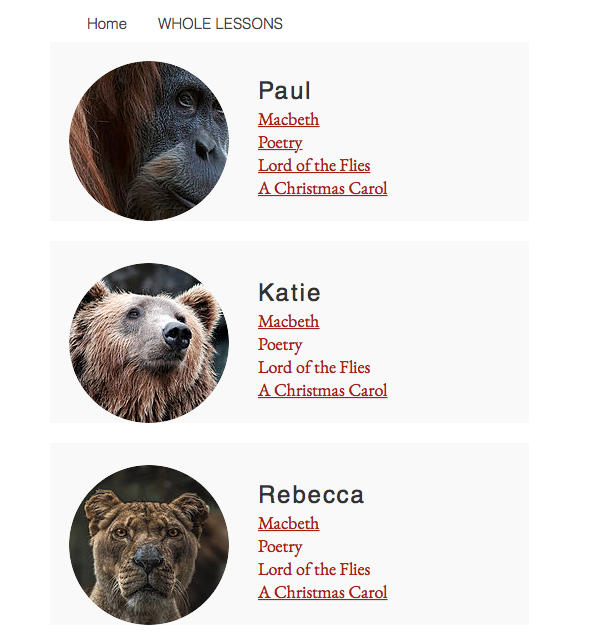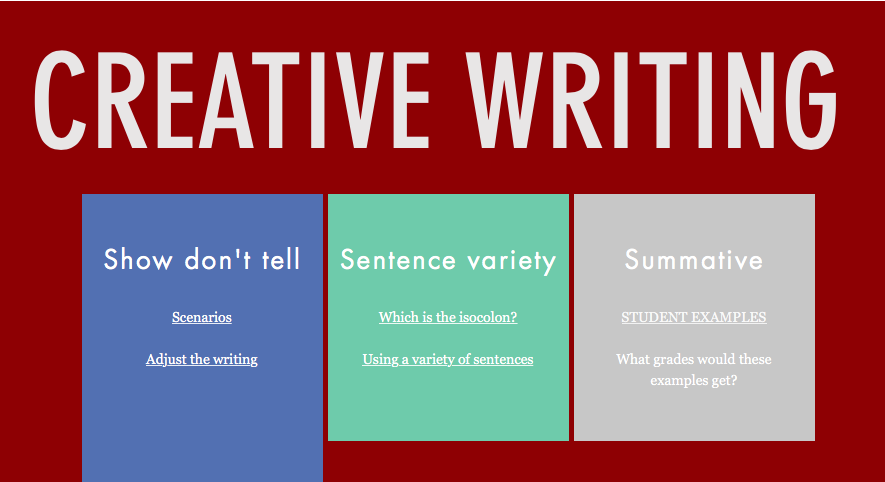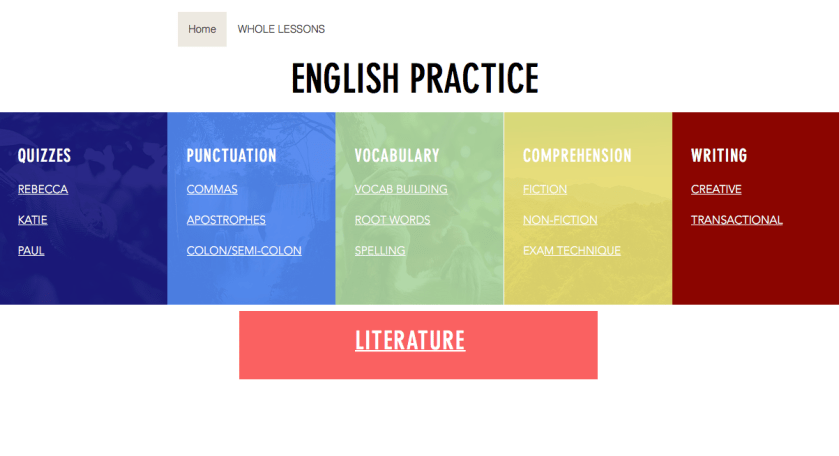It is a curation of activities designed for students to visit before and after assessment. Before, to strengthen knowledge of the course, and after, to strengthen knowledge of the course.
I have created a one-stop resource for my English GCSE students here.
Originally, the site was designed as a support tool for the Language course only, hence the dominance of Language elements in the home page design. However, Literature has now also been added.
INSPIRATION – improving feedback via assessment
One of the big changes I wanted to make with my team when I took over the role of head of department was the way we assessed and then provided feedback. I wanted to control our summative assessment more so that if students made errors I could diagnose them more easily. Effectively, I wanted something in-between formative and summative assessment.
For example, if I wanted to solely check students’ ability to respond and continuously link back to the question in an essay, I would ensure that other factors would not interfere with the validity of what I wanted the test to do. I would give students ample time, definitions of words in an extract, a reduced range of content from which the test would draw, and sometimes even provide the essay topic in advance, etc, etc. In such a case, errors were likely to reliably indicate one of two things: lack of specific content knowledge, or a lack of knowledge in how to piece the content together in an essay format. This would then make directed feedback easier: practice retrieval of content, or observe modelled responses that follow the desired argumentative style, and adjust the response accordingly.
If the task was transactional writing, a focus could be on punctuation as well as students’ ability to address the audience’s needs (polemic argument). If responses indicated an issue with using commas correctly, the teacher could direct them to activities that served to strengthen their knowledge of how and when to use them. But direct them where? TES? Random handouts? Study guides?
Take for example commas. What I realised was that there wasn’t really anything out there that took students back, as Daisy Christodoulou suggests in her seminal book ‘Making Good Progress’, to the fundamentals of knowledge in a sequential deliberate manner that would build security in knowing how and when to use them. To improve correct comma use, a student needs to firstly now what constitutes a complete thought. Everything is pointless unless this is understood.

And so, the website was born.
Assessment feedback directs students to specific activities on the website to strengthen their knowledge.
KEY FEATURES OF THE PLATFORM
TECHNOLOGICAL DESIGN –Wix.com offers a pretty user-friendly interface. The templates are easy to use and navigating through the design site is very intuitive. Pages can easily be linked, and it’s relatively easy to keep things organised. It’s also free, but you can subscribe if you want the ads taken away and want your own domain.
The activities are mostly ppts that are located in a Dropbox (OneDrive, Google Drive) folder that is shared between the team. The enormous advantage of this is that the activities are alive, and can be updated continuously without having to change the links. This is a really important element of the site, as each member of the team can be assigned some responsibility to add what amounts to be fairly simple resources. The students of course can’t edit the activities. There are 3 of us in the team, and so if we all add even 2 activities related to areas we know students have to improve, then it quickly becomes substantive and offers plenty of practice opportunities to help achieve mastery. Once the template is clear, duplicating activities is relatively easy. Directing a student to work on their spelling of homophones for example becomes more meaningful as there exists at least 6 activities for each common homophone issue. By the time the students have completed these, more should be added. If the team identifies particularly common issues amongst the cohort, those resources would get lots of attention in terms of building the number of practice tasks.
DIFFERENTIATION: Many of the activities are designed in such a way that they are developmental, increasing in difficulty as the resource grows. (Ideally this would be the case for all of them, but I haven’t had the time as of yet to fulfil this).This allows for differentiation, with directed tasks suiting the student’s current level.
KEY LEARNING FOCI
The selection of content is based on the most important elements in the course; the distinct parts that make up the summative test. As an examiner, I have the advantage of practising marking students’ work to criteria, and acquiring a strong understanding of what those isolated parts are that students need to join together and master to demonstrate proficiency. Bearing in mind that the site was set up originally as a support for struggling students, the choice of content was very much pragmatically inspired.
COMPREHENSION – An especially important section for struggling students is the comprehension section. I am convinced that practising short reading tasks is the best way to strengthen comprehension, a vital skill in facilitating success in most exams in school. Students are asked to read a short piece of text and answer questions designed to increase in difficulty as the list proceeds.

EXAM TECHNIQUE – this section helps students better understand the criteria for answering exam style questions. Students are provided with opportunities to grade submitted answers in order to help them see how marks are awarded, and thus to know how much information is required of them in answering. This is indeed quite a challenge for lots of students, knowing how much to write to satisfy the examiner, but constantly seeing it modelled is a good way to help them consolidate the information.

–

QUIZZES – Every quiz I give my classes is on here, with answers in the notes section. The quizzes are mostly Literature based. The rationale here is that students can access these at any time in their revision and retrieve the information. These serve as excellent homework activities, and students are encouraged to set themselves goals of mastery. It’s always so clear who has been doing them by the ease with which content is reproduced in assessment.
ANALYSIS PRACTICE – Practice makes perfect. Students are presented with mini extracts and are asked questions with prompts for what techniques are used to enhance the meaning of the text. This design matches the developmental ethos of the site, and consequently allows for more accurate diagnosis if issues are made. These are instructed to be 15 minute activities, again perfect for homework. They take no time at all to mark too.

STUDENT EXEMPLARS – this is a really powerful section. Seeing multiple perspectives or approaches to the same idea can help students, and an excellent way of achieving this is showing them well-constructed student responses. Whilst simply reading notes is an inefficient way to revise, seeing knowledge in context can be powerful for students who actually know the content, but struggle to form strong arguments with it or piece it together in a coherent fashion. It’s modelling 101.

GENERAL ACTIVITIES – there is quite a lot of vocab practice with a variety of activities to build vocabulary. There are also plenty of links to revision materials, such as my retrieval knowledge organiser, poetry contexts, as well as flash cards which I have and am designing for students (blog pending on the rationale for this).
FEEDBACK ON ACTIVITIES – In terms of providing feedback on the activities, it is possible to add answers in the notes section of the ppt slides, so students can self-correct. I have done this to the quizzes, but not for other tasks (another job to do).
THE FUTURE
Once again, the site is very much in its infancy. Lots of improvements can be made both content wise (more activities and greater focus on developmental movement through the knowledge) and aesthetically: consistent colour scheme, layout etc. But time is the answer to these things, as well as advice from experts. If you are able, I’d love your feedback on the whole thing.
I would like to thank my amazing team: Rebecca Walker and Katie Babbs, whose constant support and friendship is truly wonderful and inspiring.
Thanks for reading.
I’m Paul Moss. Follow me @edmerger

Wow. What a great resources. Thanks for sharing.
LikeLike
Thanks Robbie
LikeLike
*resource
LikeLike
This is exactly what 21st teaching is all about. Practical relevant resources, sharply honed and links to educational theory well. I have some enthusiastic and competent English teachers, who would be willing to share and generate resources. Please do get in touch if this is something of benefit.
LikeLike
Hi Charlotte
Oohh, tell me more
LikeLike